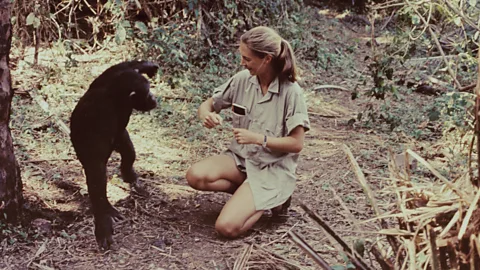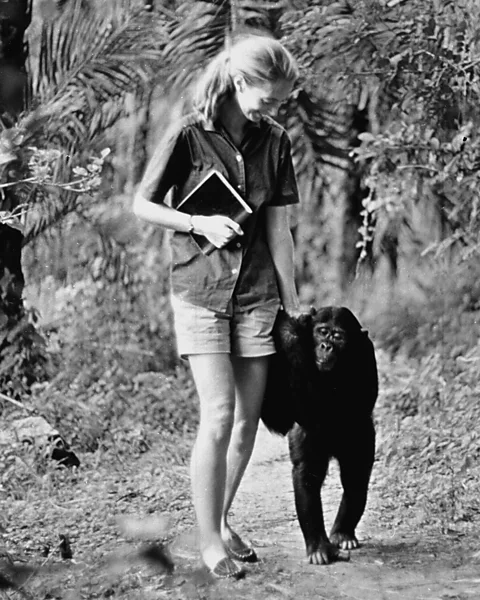'They hold hands, they embrace, they kiss': The woman who changed our view of chimps – and human beings
 Getty Images
Getty ImagesIn 1960, Jane Goodall began her groundbreaking field study by living among chimpanzees in Tanzania. In 1986 she told the BBC how similar chimps and humans really are.
On 14 July 1960, 65 years ago this week, a young English woman with no formal scientific background or qualifications stepped off a boat at the Gombe Stream Game Reserve in Tanzania to begin what would become a pioneering study of wild chimpanzees. Her discoveries would not just revolutionise our understanding of animal behaviour but reshape the way we define ourselves as human beings.
Although she was just 26 years old at the time, Jane Goodall had long dreamt of studying and living with animals. "Apparently, from the time I was about one and a half or two, I used to study insects, anything, and this gradually evolved and developed and grew and then I read books like Dr Dolittle and Tarzan, then it had to be Africa that was my goal," she told the BBC's Terry Wogan on his talk show in 1986.
Upon finishing school, Goodall took a secretarial course while working as a waitress and as a film production assistant to fund her childhood ambition. By 1957, she had finally saved enough money to travel to see a friend in Nairobi, Kenya. While there, she arranged to meet the renowned Kenyan-British palaeoanthropologist Professor Louis Leakey, merely with the hope of talking to him about animals. Leakey, whose secretary had recently left, was so impressed by Goodall's quiet determination and extensive self-taught knowledge of African wildlife that he offered her a job as his assistant at the natural history museum.
Leakey would then become Goodall's mentor. "It was he who said, 'Well, I'm looking for someone to go and study chimpanzees because of the light their behaviour may shed on understanding early human behaviour,'" she told Wogan. Leakey viewed her lack of an academic science background as an advantage rather than a hindrance, believing her observations wouldn't be hemmed in by pre-existing scientific theories.
Goodall would not be alone on her trip to the Gombe Reserve. To comply with the colonial safety regulations of the time, her mother Vanne came along as a chaperone. "Initially I wasn't allowed to be on my own," she told the BBC. "The British government as it then was said, 'No, this is absolutely almost amoral for a young girl to go out in the bush.' So, I had to choose a companion, and my mother came with me for three months."
 Getty Images
Getty ImagesThe first months proved to be tough going, with both Goodall and her mother, who were staying together in an ex-army camping tent, developing malaria. Even when Goodall was well enough to venture into the reserve, she could only go out with a local escort, and often at the sound of their approaching footsteps, the chimpanzees would simply vanish into the undergrowth. But as she learnt the forest trails and became used to moving through the dense terrain, "the authorities decided, well, I was crazy and I was OK", she said.
Once she started hiking on her own in the forested hills, she began to catch sight of the elusive primates through her binoculars from a peak overlooking two valleys. It was then that Goodall began to adopt an unorthodox immersive approach. Each day she would edge ever nearer to their feeding area with the hope of being able to sit among the chimpanzees and study them up close in their natural habitat.
Chimps use tools and communicate like humans
"I wore the same-coloured clothes every day and I think the most important thing was I never pushed it," she told BBC's Witness History in 2014. "I never tried to get too close. I would wait by a fruiting tree, where I knew the chimpanzees were coming, and when they left, I didn't follow them. Not to start with, because I felt that was pushing my luck. So gradually they came to accept that I was harmless."
As the apes lost their wariness of her, Goodall was able to sit for hours, patiently observing their behaviour and their hitherto unrecognised complex social system. She discovered that the chimpanzees were not in fact vegetarian as previously thought, but omnivorous, and would communicate with each other to hunt for meat. She was able to witness the closeness of their family bonds and how each animal's individuality would influence their behaviour.
"In chimp society, a female can be mated by all the males, or she can be led away and kept by one, and the males have very close bonds," she told Wogan. "They patrol the boundary of the community territory, they keep strangers out, they bring young new-blood females in, and all of them act as nice, tolerant, gentle, protective fathers to all the infants inside that community."
In History
In History is a series which uses the BBC's unique audio and video archive to explore historical events that still resonate today. Sign up to the accompanying weekly newsletter.
Instead of using a numbering system for her subjects, as was traditional in a research project, Goodall instead gave them names, recognising each animal's unique personality: She named one male chimp David Greybeard. It was while watching David Greybeard that she first saw him fashioning and using tools – activities that scientists had previously thought were exclusive to human beings. Indeed, at the time, toolmaking, which requires abstract thought to conceive of a tool's use in a future situation, was considered a defining characteristic of being human.
"[Chimpanzees] use more different objects as tools than any creature except ourselves. For example, a little twig from which they may strip the leaves, thus they modify it, for feeding on termites," she told Wogan. "A long stick from which they peel the bark, feeding on a very vicious biting ant and they chew it. Crumpled leaves for supping water out of a little hole when they can't reach it with their lips, or for wiping blood off their bodies. And weapons: stones hurled, branches used for intimidation or for clubbing."
At the time, the idea was revolutionary, challenging years of conventional scientific thinking. Since then, research has shown evidence of tool use across the animal kingdom, from the Indonesian octopus who uses coconut shells discarded by humans as armour against predators, to New Caledonian Crows who bend twigs and wires with their beaks to create hooks, enabling them to pull larvae out of tree bark.
As Goodall sat silently observing the chimpanzees, she began to see how similar their familial bonds and their non-verbal communication were to those of humans. "If chimps meet after a separation, they hold hands, they embrace, they kiss," she said. Understanding of this commonality with humans raised "new questions about the way that we are bringing up our children in the West", she told Wogan.
A common ancestor
"Well, if we leave a child crying at night, if we leave a child for long hours in a playpen, if we take a child to a daycare centre where there is a constant turnover of people, we may bring up a child that is highly intelligent. But from our experience of chimps who've had difficult upbringings, there is a suggestion that that child when it is an adult may have difficulty in making close relationships with others – may find it harder to cope in a stressful situation. This is very important," she said.
Goodall recognised how closely chimpanzees' ritualised behaviours and emotions can resemble our own. And how, like ours, their destructive and violent impulses could lead to brutal killings. "We discovered after the first 10 years that although chimps were very like us in their friendly ways, they're also like us in the fact they can become very aggressive. We found that under certain situations, there can be cannibalism and also an inter-community interaction that in some way is like a primitive form of human warfare," she said.
In 1962, with Leakey's encouragement, despite not possessing an undergraduate degree, she began a PhD based on her exceptionally detailed findings. The same year, the National Geographic Society sent a Dutch wildlife photographer and film-maker, Hugo van Lawick, to document her work, which resulted in a 1965 documentary, Miss Goodall and the Wild Chimpanzees. Narrated by Orson Welles, the film helped showcase her discoveries to the wider public. Van Lawick would become her first husband, and in 1967, the year after she gained her doctorate, she gave birth to a son, Hugo, whom they nicknamed Grub. They built him a protective shelter to enable Goodall to remain with him and keep him safe while she continued her field work.
"Chimpanzees are hunters just like we are," she told Wogan. "They hunt co-operatively, they hunt medium-size mammals. There had been records of them hunting human children, just as humans hunt chimps, and so when he was very tiny and this was before he could walk, he was in a sort of caged-in veranda, and we always had to have people with him."
Goodall's trailblazing research into primatology presented evidence that humans are not separate from the rest of animal kingdom, but that Homo sapiens and chimpanzees share a common ancestor. Research has since shown that chimpanzees are incredibly genetically close to humans, sharing about 98.6% of our DNA.
"This is the thing," said Goodall. "Behaviour we see in man today and chimp today was probably in that common ancestor, and therefore we can imagine Stone Age people having long friendly relationships between family members and using little twigs to feed and embracing one another. I like to think of that."
--
For more stories and never-before-published radio scripts to your inbox, sign up to the In History newsletter, while The Essential List delivers a handpicked selection of features and insights twice a week.
